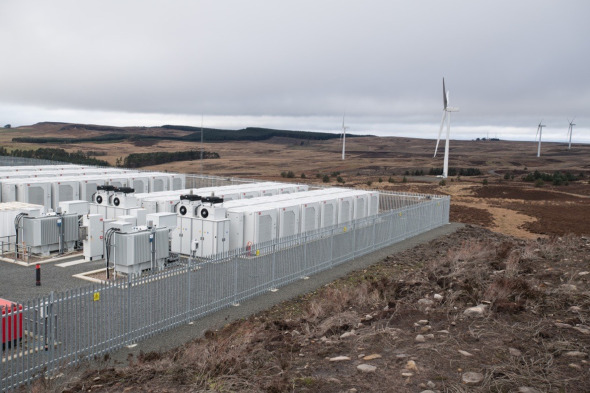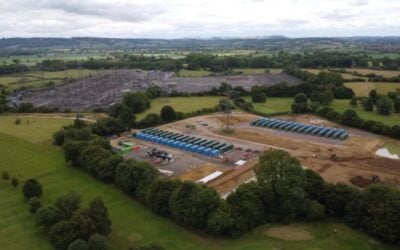
Successful optimisation of batteries co-located with wind is complex but could help “unlock a blueprint” for managing assets at portfolio level, the chief executive of UK software company Arenko has said.
Arenko is a provider of software for managing and trading of energy assets, with a background in battery storage. Chief executive Rupert Newland spoke with Energy-Storage.news about how its software is working to manage a battery energy storage system (BESS) which shares a grid connection with a wind power plant.
Enjoy 12 months of exclusive analysis
- Regular insight and analysis of the industry’s biggest developments
- In-depth interviews with the industry’s leading figures
- Annual digital subscription to the PV Tech Power journal
- Discounts on Solar Media’s portfolio of events, in-person and virtual
The wind farm and battery belong to utility Vattenfall, which Newland describes as a pioneer in the space, being the first company to co-locate the two technologies at scale in the UK. The pair have worked together since 2022, when Vattenfall’s first wind-plus-storage site went live, and Arenko’s enterprise software Nimbus has now been in use to optimise operations at its second for about three weeks.
Arenko began optimising a 22MW/16MWh short-duration BESS at Vattenfall’s 228MW Pen y Cymoedd (PYC) Wind Farm in Wales from mid-2022, marking the UK’s first example of that co-location. In the more recent example, in Northumberland in northern England, a 20MW/45.5MWh battery storage system is paired with Vattenfall’s 54.4MW Ray Wind Farm.
There’s a big difference between the two and how the different technology types interact. The first co-located project, which Arenko began optimising after its contract to supply the enhanced frequency response ancillary service to the grid ended, had a grid connection sufficient to allow the BESS and the wind farm to operate fully independently.
“The first one (PYC) was a battery that had a clear headroom to operate on that site. So essentially, the grid connection was larger than the overall output of the wind farm so the battery can operate as a sort of standalone battery,” Newland told Energy-Storage.news in an interview.
“The second project is restricted by the wind [generation]. So the grid connection is a fixed level, it’s a constraint on the overall nexus of battery and wind. So if the wind is generating, then the battery cannot [output to the grid], and so you’ve got to optimise around the wind.”
Optimising a portfolio
Finding a solution to that at the second co-located site at Ray was “hugely challenging,” according to Newland, requiring the integration of live wind data, including wind and expected output forecasts, into the Nimbus platform. The fact that all of this data is constantly changing made this all the more challenging.
“You need to be able to understand how that wind farm is going to perform, in order to then be able to optimise the battery that sits around it. Being able to understand that relationship in a in a great level of detail, allows you then to fully automate the operations, the battery system, around the performance of the wind,” Newland said.
Asset owners and investors in renewables are recognising that there is value in putting battery storage onto their solar PV or wind generation sites in future, but find the technical challenge of controlling two assets – one dispatchable and controllable (BESS) and the other variable (renewables) – that essentially “compete” for the same grid connection, to be a barrier.
The rewards of being able to do it, as Arenko claimed it can, begin with enabling a particular site to generate much higher return on investment and optimise the performance of that asset, or assets. But a much more important takeaway from the co-location case study, according to Newland, is the lesson it teaches for how to manage and optimise assets of different technology types at portfolio or fleet level.
Arenko’s customers include other big multinational energy companies like ENGIE, with which it is doing the first onboarding of a solar-plus-storage plant onto the Nimbus platform, and investors in the UK market like Foresight Group and Gresham House Energy Storage Fund.
More and more customers are seeking to optimise at portfolio level, and across a sometimes quite diverse range of technologies, including BESS, solar and wind and ‘conventional’ generation assets, Newland said.
That’s precipitating a “rapid move into renewables” for the company, which both manages assets via Nimbus and sells or licenses the software platform.
“The co-located deals are the first step into that renewable space and we’ve had to solve many of the kind of very, very challenging data management and operational challenges associated with automating wind power in this instance, but we’ve also done our first solar deals, which will be online later this year.”
A blueprint for co-location
The new BESS at Vattenfall’s Ray wind farm has been “performing brilliantly” so far, the chief executive claimed.
“We’re incredibly proud of the performance and it’s something that we’ll be talking more and more about as we get more and more definitive data to prove the performance,” Newland said.
“It’s been pretty windy recently as well. So it’s [the battery storage] been quite heavily constrained, so it’s a real proof of concept.”
Renewable energy markets, including the UK, are seeing increasing amounts of solar-plus-storage, but far less co-located wind-plus-storage. This is partly due to the much less predictable nature of wind generation, which makes optimisation alongside batteries more difficult, while batteries themselves are perhaps the most complex of any generation asset to optimise, Newland believes.
Being able to do so successfully means understanding the performance of each asset, potentially creating “a blueprint for actually being able to do this at scale across multiple different sites at all times”.
“And that is the same proxy for a diversified portfolio as well,” Newland said.
Energy-Storage.news’ publisher Solar Media will host the 9th annual Energy Storage Summit EU in London, 21-22 February 2024. This year it is moving to a larger venue, bringing together Europe’s leading investors, policymakers, developers, utilities, energy buyers and service providers all in one place. Visit the official site for more info.






